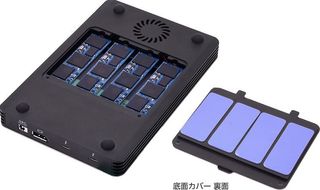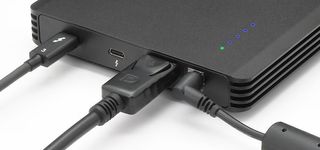Century Reveals RAID 0 M.2 NVMe Thunderbolt 3 External Exclosure
Worlds fastest external storage

If you want super-fast external storage, Century might have just the solution for you: The company has unveiled an all-new M.2 SSD external enclosure featuring M.2 RAID 0 support for what it claims are the fastest read and write speeds from a portable device.
The external enclosure sports a 15W power delivery system, allowing the enclosure to run up to four NVMe SSDs at up to PCI-E Gen 3.0 speeds with all four SSDs in RAID 0. Due to the system being a software RAID, maximum theoretical speed can be up to 2550 MBps, which is incredibly quick for an external storage solution. The enclosure also features active cooling to help cool off the flash and memory controllers on your M.2 NVMe drives, which tend to get hot with no airflow.

Technically you can use any M.2 NVMe Gen 3.0 or Gen 4.0 SSD in the enclosure. However, Century does recommend four specific SSDs from Seagate, Western Digital, and ADATA for maximum compatibility: The Seagate BarraCuda 510 and FireCuda 510/520, the WD Black SN750, and ADATA XPG SX8200 Pro.
For the rear I/O, you get two Thunderbolt 3 ports, a single Displayport 1.2 for daisy-chaining a monitor if needed, and finally, a DC port for power.
This is a great solution if you need high-speed storage on the go. You'll have to supply the SSDs yourself, but you have the benefit of using your own SSDs for your own specific needs. At this time, there is no word on availability or pricing.
Stay on the Cutting Edge
Join the experts who read Tom's Hardware for the inside track on enthusiast PC tech news — and have for over 25 years. We'll send breaking news and in-depth reviews of CPUs, GPUs, AI, maker hardware and more straight to your inbox.

Aaron Klotz is a freelance writer for Tom’s Hardware US, covering news topics related to computer hardware such as CPUs, and graphics cards.
-
twotwotwo Dunno about those drive suggestions: you'd be paying for extra GB/s you couldn't use through TB3. Four WD Blues/Intel 665p's still move 40Gb/s easily but might save you $100 (across the four sticks) vs. the suggested higher-end choices.Reply
(Yay for consumer NVMe RAID though, at ~10c/GB it's not such a wild/niche idea!) -
USAFRet Reply
Why?twotwotwo said:(Yay for consumer NVMe RAID though, at ~10c/GB it's not such a wild/niche idea!)
What benefit does a RAID 0 bring to the consumer level? -
twotwotwo I guess I shouldn't've said a declarative sentence on the Internet if I didn't want an argument but: you might want more Flash than is cost-effectively available in a single drive, and RAID can be a convenient way to access multiple drives and take advantage of their combined throughput. (In other contexts it can help with hardware reliability, though that wouldn't be the case with this enclosure, which is RAID 0.)Reply
I'm not saying you or me or everyone should do it, but doesn't seem outlandish! -
USAFRet Reply
No, not an argument.twotwotwo said:I guess I shouldn't've said a declarative sentence on the Internet if I didn't want an argument but: you might want more Flash than is cost-effectively available in a single drive, and RAID can be a convenient way to access multiple drives and take advantage of their combined throughput. (In other contexts it can help with hardware reliability, though that wouldn't be the case with this enclosure, which is RAID 0.)
I'm not saying you or me or everyone should do it, but doesn't seem outlandish!
But we've seen many many people with the desire for a RAID 0 + NVMe, simply because they heard the term RAID 0, and that it is magically faster.
Outside very rare use cases, it isn't. -
escksu Thundebolt is essential PCIE 3.0 x4. Same as nvme. The problem is that this is limited to 4GB/s.... Thats why PCIE 3.0 nvme drives can't go higher, need PCIE 4.0Reply
So, I don't see how this RAID can overcome this 4GB/s bottleneck. -
junglist724 Reply
Yeah wtf is the point of putting 16 lanes worth of SSDs in an enclosure that is connected to your pc by 4 lanes.escksu said:Thundebolt is essential PCIE 3.0 x4. Same as nvme. The problem is that this is limited to 4GB/s.... Thats why PCIE 3.0 nvme drives can't go higher, need PCIE 4.0
So, I don't see how this RAID can overcome this 4GB/s bottleneck. -
twotwotwo Replyjunglist724 said:Yeah wtf is the point of putting 16 lanes worth of SSDs in an enclosure that is connected to your pc by 4 lanes.
I think the trick is to fill it with lower-end NVMe drives that each move less than 4 GB/s, and then combined you can have 4-8 TB at...a decent number of GB/s for your MacBook Pro or whatever, while paying ~10c/GB for lower end SSDs. If they don't wildly overprice the enclosure, it could beat a lot of current TB3 SSDs on price.
Of course, you don't have to buy it if that doesn't do anything for you. I don't have TB3 and haven't filled the one internal SSD on this laptop, so... -
spongiemaster Reply
It can't. The spec page says that a single drive tops out around 750MB/s which isn't great. USB 3.2 peaks around 1000MB/s with an NVME drive. So, speed is getting lost somewhere along the line for each drive. With RAID, speed can increase to 2550MB/s, which is pretty decent for an external drive.escksu said:Thundebolt is essential PCIE 3.0 x4. Same as nvme. The problem is that this is limited to 4GB/s.... Thats why PCIE 3.0 nvme drives can't go higher, need PCIE 4.0
So, I don't see how this RAID can overcome this 4GB/s bottleneck. -
joevt1 Reply
Right. This is the same configuration as the OWC Express 4M2. One PCIe 3.0 x1 lane per NVMe with a DisplayPort 1.2 output (OP incorrectly says DisplayPort 1.4).spongiemaster said:It can't. The spec page says that a single drive tops out around 750MB/s which isn't great. USB 3.2 peaks around 1000MB/s with an NVME drive. So, speed is getting lost somewhere along the line for each drive. With RAID, speed can increase to 2550MB/s, which is pretty decent for an external drive.
The reason for only one lane per NVMe is for cost. The single lanes come from the Alpine Ridge Thunderbolt controller directly. To get 4 lanes per NVMe would require a PCIe 3.0 switch with at least 20 lanes which is very expensive.
The point of these enclosures is capacity but it can also do performance with software RAID. With software RAID, you can actually get better performance than with an enclosure with a single x4 NVMe because those usually have poor write speed (down to 800 MB/s for some) compared to read speed (2500 MB/s) while in a Thunderbolt enclosure (Thunderbolt is limited to ~2750 MB/s). With Software RAID, even if the write performance per NVMe is low, it adds up. I don't know of a single NVMe that has good write performance in a x4 Thunderbolt enclosure - these x1x1x1x1 Thunderbolt enclosures can fix that problem. Would be nice to see some benchmarks to be sure.
As for USB 3.1 gen 2 (10 Gbps) remember there are the ASMedia ASM1142 controllers that are also limited to 750 MB/s because of the PCIe connection (either PCIe 2.0 x2 or PCIe 3.0 x1). You need a USB controller with PCIe 3.0 x2 or greater to get the 1000 MB/s numbers. -
Lostinlodos Just one question? JBOD?Reply
I don’t care about raid.
I currently use internal SATA SSDs with SATA to usb 3.1/3.2 plugged in to a USB3x hub connected to my Mac via USB3. Adding 4 drives to a single port would be nice. If I can do away with the raid nonsense.
Yes I know the what and why of raid, I prefer the oldskool backup methodology. right or wrong I see raid as another level of failure points. And avoid it.
Most Popular






